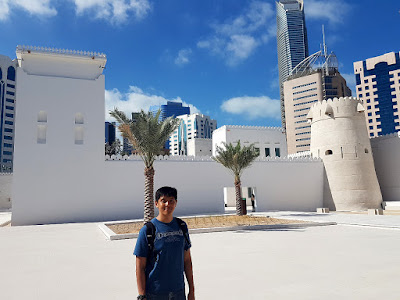Rashid Bin Saeed Al Maktoum Street, Abu Dhabi, United Arab Emirates
Sat-Thu: 9.00am - 7.00pm
Fri: 12 noon - 10.00pm
Promoting itself as the "cornerstone of Emirati culture and history", Qasr al-Hosn was originally erected as a watch tower in 1761 to defend the one and only freshwater well in Abu Dhabi before it grew into a fort. After years of intensive conservation and restoration work, it has finally reopened as a museum.

My BFF and I were so lucky that we happened to be in Abu Dhabi on the first week of the reopening of Qasr al-Hosn in December 2018. Take a look at its outer walls and the surrounding structures.
 |
| There are a few old cars being displayed. |
 |
| Al Hosn Pavilion is where certain performances and workshops take place. |
After passing the gate, we were escorted to the ticketing office to purchase admission tickets. For an adult, it costs AED 30.00 (~S$11.15). A child pays half of that amount.
 |
| Feel free to take a photo with those 'soldiers'. |
The ticketing office has a small array of objects on display.
 |
| You can see the evolution of Qasr al-Hosn over the years. |
 |
| There's an interactive panel that gives a short summary of the history of Qasr al-Hosn. |
 |
| Without reading the description, I wouldn't have guessed that those are cannon balls. |
Exiting the ticketing office, we were told to go to the building across the office to start our museum experience. Each section is manned by a staff member who's more than eager to share their knowledge with you.
 |
| I enjoyed the animated projection on the wall. |
 |
| Have you ever seen a heart-shaped world map dating back to 1559? |
The defensive structure of Qasr al-Hosn was expanded in 1975 to protect the nearby emerging settlement. By 1833, the population count had grown to over 12,000, signalling the birth of Abu Dhabi as a major town of the Gulf coast.
 |
| Abu Dhabi used to be a desert. |
Born in 1918, Sheikh Zayed bin Sultan Al Nahyan was the founding father of the UAE, becoming the first president of the nation from 1971 until his death in 2004. The year 2018 was celebrated as the Year of Zayed, marking 100 years since the birth of Sheikh Zayed.
 |
| Do you prefer rifles or swords? |
 |
| In the late 1800s, the Sultanate of Oman gave a cannon to Sheikh Zayed as a symbol of friendship. |
Here are some photos taken at the last section of that building.
 |
| The original gates of the fort feature intimidating spikes. |
 |
| Abu Dhabi is blessed with sea that has been providing fish and pearls all along. |
 |
Don't forget to go to the small room on the second floor to check out more things.
Chairs are also available there should you need to rest. |
From the building, we walked over to and admired the watch tower mentioned at the beginning of this post.
Beating the heat of the midday sun, we explored the grounds of the fort.
 |
| The ambience is marred by those modern buildings in the background. |
 |
| The second part of the museum are split into small rooms along the corridors. |
The various rooms on the first floor give a glimpse into the
 |
| The fort then became the permanent residence of the ruling family until 1966. |
 |
| Those are coffee cup fragments found at the site. |
 |
| Feel free to take a copy of the trucial states passport as a memorabilia. |
 |
| I enjoy dishes that include turmeric as one of the ingredients. |
 |
| The flag of Abu Dhabi, one of the seven emirates constitute the UAE~ |
Let's climb the stairs to the second floor.
 |
| Melon was trying to imagine living in the fort. |
 |
| Those are Sheikh Zayed's brothers. |
 |
| There's a room where you can assemble the fort using either hard or pillowy blocks. |
Qasr al-Hosn festival is an annual 11-day event that's usually held in February, featuring the rich cultural heritage of the UAE through live performances.







































































Comments
Post a Comment